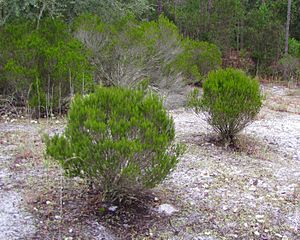Ceratiola facts for kids
Quick facts for kids Ceratiola |
|
|---|---|
 |
|
| Scientific classification | |
| Genus: |
Ceratiola
|
| Species: |
ericoides
|
| Synonyms | |
|
|
Ceratiola ericoides, often called sand heath or Florida-rosemary, is a unique type of shrub. It's the only plant in its group, which scientists call the Ceratiola genus. This plant is usually part of the Ericaceae family, which includes many well-known plants like blueberries.
About Florida-Rosemary
Florida-rosemary is a shrub that can grow from about 1.5 to 8 feet tall. That's like growing from half the height of an adult to taller than a basketball hoop! It has small leaves that look a bit like the herb rosemary, but it is not related to true rosemary and is not safe to eat.
This plant blooms in the spring, summer, and fall. It grows in special areas called maritime hammocks, which are usually near the coast.
Where It Lives
Florida-rosemary is found in the coastal Southern United States. You can see it in states like Alabama, Florida, Georgia, Mississippi, and South Carolina. It loves dry, sandy places, especially areas with scrubland.
It often grows alongside sand pine trees and different kinds of oak trees. These plants are tough! They are used to living in harsh coastal environments. This means they can handle very hot sun and sandy soils that drain water quickly.
Why It's Special
One cool thing about Florida-rosemary is how it deals with forest fires. Fires are a natural part of its habitat. After a fire, the plant regenerates by growing from its seeds. This helps new plants grow and keeps the ecosystem healthy.
This plant's home is also very important for a special animal. The endangered Florida sand skink (Neoseps reynoldsi) lives in central Florida. This small lizard depends on the habitat where Florida-rosemary grows. Protecting these plants helps protect the skink too!
The name "Florida-rosemary" comes from how its leaves look. They are similar to the European shrub rosemary, which is a popular cooking herb. But remember, Florida-rosemary is not edible, so don't try to eat it!
See also

- In Spanish: Ceratiola ericoides para niños

